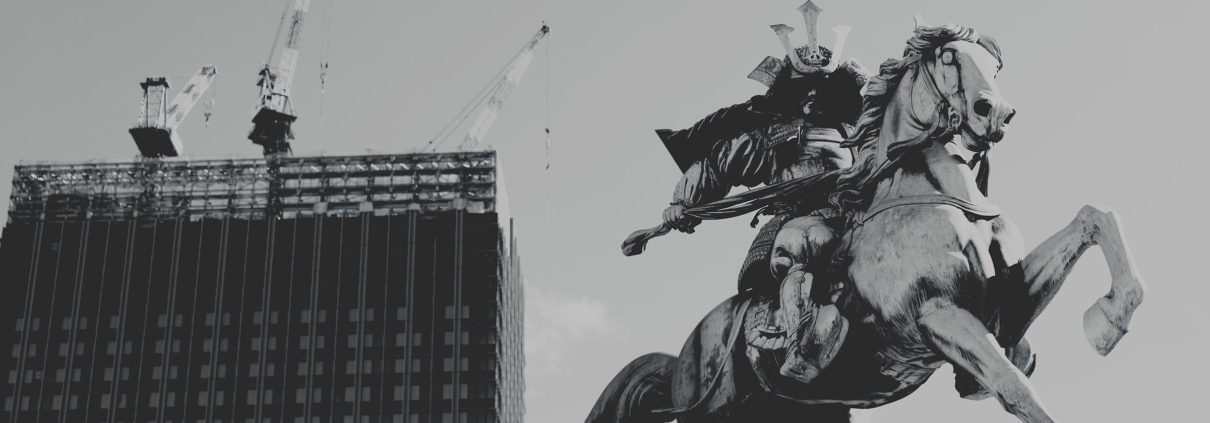Pt. 1: From Samurai to Steam Locomotives
Population in 1850: 32 million people
Population in 1900: 44 million people
Japan went from samurai, feudal warlords, and a largely agrarian society under the Tokugawa shogunate in the Edo period to men wearing western suits, Japan’s industrial revolution, and a Western-style parliament, government, and military in the Meiji period.
Many residents of Japan and academics know the gist of this, but what really happened with Japan’s Industrial Revolution and how did it take us into the present age?
The Meiji period only lasted 45 years but brought with it rapid, sweeping changes to Japan. Chiefly responsible were a handful of influential people deadset on modernizing Japan by adopting Western ways while building up its own power & influence as a unified state in order to avert the very real threat of colonization.
It was not a peaceful transition from samurai to suits. There were many who opposed this shift in power, which came as the result of bloody conflict.
Japan opened itself to the West in 1853, when Commodore Matthew Perry of the US Navy arrived with a fleet of massive black ships led by the USS Mississippi to demand the opening of the country to trade. After a year of animated deliberation, in 1854 the shogunate agreed to the Japan-US Treaty of Peace and Amity.
This is where things begin to escalate. Over the course of 1863-64, the powerful feudal domains of Satsuma and Choshu were attacked in by a British and then a combined international force. While the samurai warlords of these 2 domains had initially thought that expelling foreigners from Japan was the only way to avert colonization, they shifted their thinking and in 1866, the former rival domains secretly formed the Satsuma-Choshu Alliance to rapidly construct a modern state in order to prevent Japan from becoming a colony.
After some conflicts that proved that the Tokugawa Shogunate was quickly losing its grip on power, the last shogun, Tokugawa Yoshinobu, relinquished power to the young Emperor Meiji, although Tokugawa still eyed being a senior leader under the auspice of the imperial court. However, Satsuma and Choshu had other ideas. They began a violent and unrelenting campaign to destroy the forces opposed to their machinations.
In 1868, the Satsuma-Choshu Alliance took over the Imperial Palace in Kyoto by force, (dramatized in the 2003 film The Last Samurai) and issued an edict restoring imperial rule. This coup d’état is what is seen as the birth of the Meiji Restoration. However, the bloodbath was far from over. In the conflict that initiated the Boshin Civil War, the forces of the new Meiji government obliterated those of the Tokugawa shogunate and Tokugawa Yoshinobu fled to Edo.
So, the Meiji government army chased after him. 50,000 troops surrounded Edo, but negotiations resulted in the peaceful and unconditional surrender of Edo Castle. This avoided a devastating all-out attack and spared Tokugawa Yoshinobu. However, battles against the Meiji government continued in northern Japan through 1869, when the last supporters of the shogunate were defeated and all domains surrendered their territory and citizens to the new Japanese state.
The emperor moved to Edo Castle, which became the Imperial Palace, Edo was renamed Tokyo and became the nation’s capital, and the era name was changed to Meiji.
In 1871, domains were officially replaced by prefectures. However, more conflict arose in 1876 when the Meiji government prohibited wearing swords and abolished hereditary stipends, which infuriated the samurai class and led to the Satsuma Rebellion. Meiji forces once again opened a can of whoopass and the last samurai rebellion was crushed. In 1889, after intense discussion among powerbrokers, thought leaders, and other influencers, the Meiji Constitution was established, Japan’s first constitution.
This unified state saved Japan from its nightmare situation of being colonized by a Western power, which most of the rest of Asia experienced, but it did not come with economic equality. There was still very much a caste system in place where the Imperial government, lords, and political influencers called the shots, and economic conglomerates were built by their cohorts. Near to the bottom were traders and farmers, only above burakumin or untouchables who were delegated to trades that were considered dirty and undesirable.
With modernization came rapid industrialization and also a rapidly increasing population.

 Parthenon Japan
Parthenon Japan Parthenon Japan
Parthenon Japan